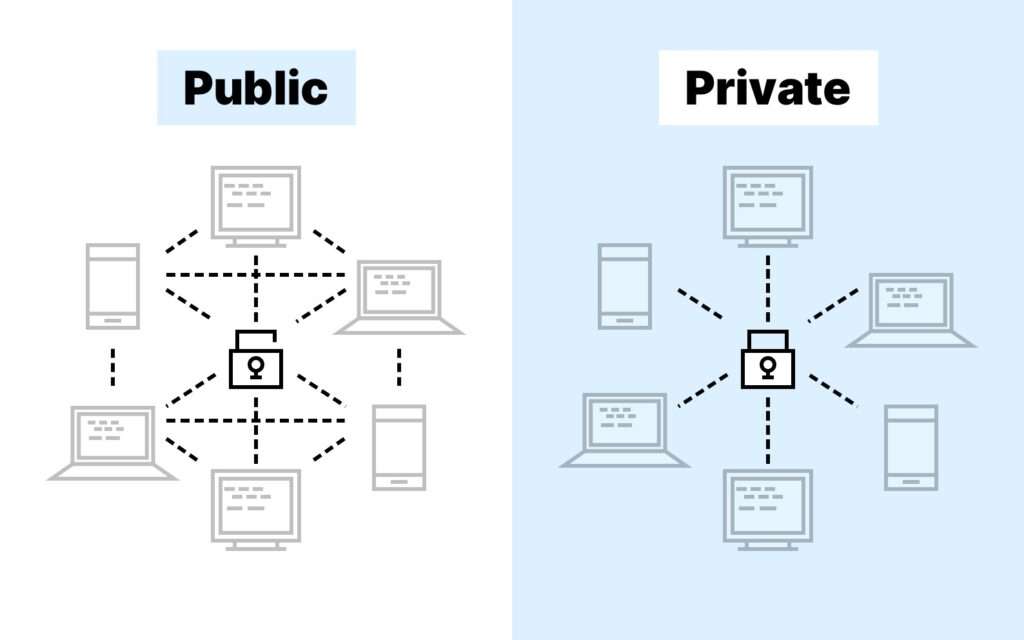Private Blockchain vs Public: Understanding the Key Differences

Blockchain technology has evolved beyond its early cryptocurrency applications to become a transformative force across industries. At its core, blockchain offers a distributed ledger system that records transactions securely and transparently. However, not all blockchains are created equal. The fundamental divide between private and public blockchains represents different approaches to accessibility, control, and functionality.
Fundamentals: What Makes a Blockchain Public or Private?
Public and private blockchains differ primarily in who can participate in the network, validate transactions, and access the data. These fundamental differences shape everything from security protocols to performance capabilities.
Public Blockchains
Public blockchains operate as open networks where anyone can participate without permission. Bitcoin, launched in 2009, pioneered this model, creating a system where transactions could occur without intermediaries like banks or payment processors.
Private Blockchains
Private blockchains, by contrast, restrict access to selected participants. A central authority determines who can join the network, validate transactions, and access data. This design prioritizes business privacy and controlled information sharing.

Key Differences Between Public and Private Blockchains
| Feature | Public Blockchain | Private Blockchain |
|---|---|---|
| Access | Open to anyone | Restricted to authorized participants |
| Consensus Mechanism | Typically Proof of Work or Proof of Stake | Varied (PBFT, PoA, etc.) |
| Transaction Speed | Generally slower (3-20 TPS for Bitcoin/Ethereum) | Faster (1,000+ TPS possible) |
| Energy Consumption | Higher (especially for PoW) | Significantly lower |
| Transparency | Complete transaction visibility | Customizable privacy settings |
| Security Model | Cryptoeconomic incentives | Access controls and traditional security |
| Use Cases | Cryptocurrencies, global applications | Enterprise solutions, controlled ecosystems |
| Governance | Community-driven | Centrally managed |
Security Considerations
Public Blockchain Security
Public blockchains secure transactions through distributed consensus mechanisms and cryptographic verification. Their security relies on:
- Economic incentives that make attacks financially impractical
- Widespread distribution of nodes across the globe
- Open-source code that undergoes continuous community scrutiny
- Immutability of recorded transactions
The primary vulnerability of public blockchains is the “51% attack,” where a single entity could theoretically control most of the network’s computing power. However, for established networks like Bitcoin, the resources required make such attacks prohibitively expensive.
Private Blockchain Security
Private blockchains take a different approach to security:
- Restricted access through identity verification and permission systems
- Fewer validators, but each is known and accountable
- Enhanced privacy protections for sensitive business data
- Customizable security features based on specific organizational needs
The primary security concerns for private blockchains revolve around centralized control points and the potential for insider threats.
Performance and Scalability
Performance differences between public and private blockchains are substantial:
Public Blockchain Performance
- Transaction throughput: Limited by consensus mechanisms (Bitcoin: ~7 TPS, Ethereum: ~15-30 TPS)
- Confirmation times: Often minutes or longer
- Network congestion during high-demand periods
- Scaling solutions under development (Layer 2 solutions, sharding)
Private Blockchain Performance
- Transaction throughput: Significantly higher (1,000+ TPS)
- Near-instantaneous confirmations possible
- Consistent performance regardless of external network conditions
- Customizable parameters to optimize for specific use cases
Use Cases and Applications
The choice between public and private blockchains depends largely on the specific needs of the application:
Public Blockchain Applications
- Cryptocurrencies and digital payment systems
- Decentralized finance (DeFi) platforms
- Non-fungible tokens (NFTs) for digital ownership
- Global supply chain tracking accessible to all stakeholders
- Public record systems (property records, identity verification)
Private Blockchain Applications
- Financial services with confidential client information
- Healthcare record management with strict privacy requirements
- Supply chain management within closed business ecosystems
- Internal corporate record-keeping and audit systems
- Governments managing sensitive citizen data
Hybrid Approaches: Getting the Best of Both Worlds
The blockchain landscape is increasingly moving beyond the strict public/private dichotomy toward hybrid models:
- Consortium blockchains: Operated by groups of organizations rather than a single entity
- Permissioned public blockchains: Open access for reading data but restricted access for validating
- Sidechain solutions: Private chains that periodically anchor to public blockchains
- Layer 2 solutions: Building private or semi-private functionality atop public infrastructure
These hybrid approaches aim to balance the transparency and security of public blockchains with the privacy and efficiency of private networks.
The Future Landscape
The evolution of blockchain technology points toward several emerging trends:
- Increased interoperability between public and private systems
- Development of privacy-enhancing technologies for public blockchains
- Standardization of governance frameworks for enterprise blockchain
- Greater regulatory clarity surrounding different blockchain models
- Expansion of use cases beyond financial applications
As these technologies mature, the distinctions between public and private blockchains may become less rigid, with organizations selecting components from each model to build solutions tailored to their specific needs.
FAQ
Can a private blockchain convert to a public blockchain later?
Yes, technically a private blockchain can be converted to public, but this transition involves significant architectural changes. The consensus mechanism would need to be replaced, security models restructured, and governance frameworks completely overhauled. Most organizations finding themselves in need of both models typically opt for either a hybrid approach or maintaining separate systems rather than conversion.
Are private blockchains truly “blockchains” if they’re centralized?
Private blockchains maintain the core technical elements of blockchain technology—distributed ledgers, cryptographic security, and sequential block creation. However, they sacrifice some degree of decentralization for privacy and performance. Whether this makes them “true” blockchains is largely philosophical; from a technical perspective, they implement the fundamental blockchain data structure while modifying the consensus and access layers.
Which costs more to operate, public or private blockchains?
The cost structures differ significantly. Public blockchains distribute operational costs across all participants, with users paying transaction fees. Private blockchains concentrate costs on the maintaining organization(s), requiring investment in infrastructure, maintenance, and security. For large-scale applications, private blockchains often prove more cost-effective per transaction, while public blockchains eliminate the need for building proprietary infrastructure.
Can data from private blockchains be verified by external parties?
Yes, private blockchains can implement selective transparency features. Methods include cryptographic techniques like zero-knowledge proofs that verify information without revealing underlying data, audit nodes with read-only access for regulators, and timestamping or anchoring approaches that record private blockchain state fingerprints on public chains for external verification.
Will one model eventually become dominant in the industry?
Rather than one model prevailing, we’re seeing increasing specialization. Public blockchains continue to dominate open financial systems and global applications requiring trustless interactions. Private blockchains are becoming standard for business consortiums and enterprise applications with defined participant groups. The future likely involves greater interoperability between these systems rather than one replacing the other, with technology choices guided by specific use case requirements rather than ideology.



